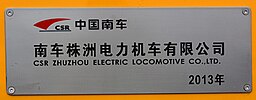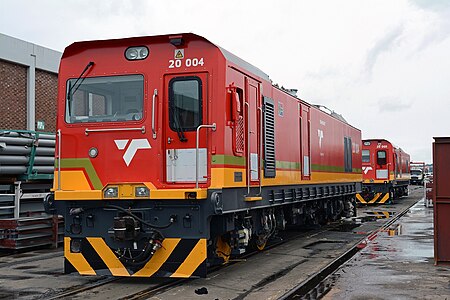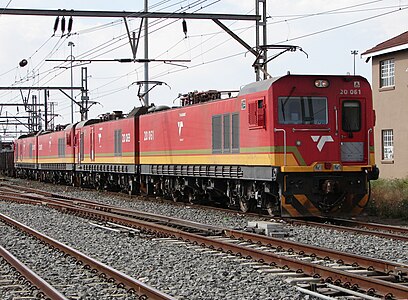TFR class 20E
| TFR class 20E | |
|---|---|
|
20 002 on delivery in Durban in November 2013
|
|
| Numbering: | 20 001 - 20 0095 |
| Number: | 95 |
| Manufacturer: | CSR Corporation |
| Year of construction (s): | 2013-2015 |
| Axis formula : | Bo'Bo ' |
| Gauge : | 1067 mm ( cape track ) |
| Length over coupling: | 18,268 mm |
| Height: | 3850 mm |
| Width: | 2950 mm |
| Bogie axle base: | 2700 mm |
| Top speed: | 100 km / h |
| Continuous output : | 3 MW |
| Starting tractive effort: | 320 kN |
| Braking force: | 250 kN |
| Driving wheel diameter: | 1220 mm |
| Power system : | 25 kV 50 Hz ~ 3 kV = |
| Number of traction motors: | 4th |
| Drive: | Pawbearing drive |
The Transnet Freight Rail Class 20E is one of 2,013 built by 2015 four-axis dual-system - electric locomotive for freight of Transnet Freight Rail in South Africa .
history
In September 2012, TFR signed a contract for the delivery of 95 locomotives for 2.6 billion rand , which was about 150 million euros . The supplier is a consortium consisting of the Chinese Zhuzhou Electric Locomotive Company (ZELC), a subsidiary of the China South Locomotive and Rolling Stock Corporation (CSR), and the South African BEE consortium Matsetse Basadi. When it was signed, the contract was the largest single order for the export of electric locomotives that ZELC had signed. It also included a manufacturing technology transfer to South Africa so that 60% of the added value can be generated in South Africa.
The first ten locomotives were manufactured in China at the ZELC factory in Changsha . The roll-out ceremony took place with the 20 001 locomotive on August 20, 2013.
The first two locomotives with the numbers 20 002 and 20 003 arrived in the port of Durban on November 14, 2013 . Three more with the numbers 20 001, 20 004 and 20 005 arrived on December 18, 2013. The locomotives with the numbers 20 011 to 20 025 were built from semi knocked down kits in the maintenance workshop Koedoespoort of Transnet Engineering, a subsidiary of Transnet responsible for the maintenance of the rolling stock, and were in use in September 2014.
The remaining locomotives on the order had a higher proportion from South Africa and were also built in Koedoespoort. The first locomotive from this part of the order was number 20 026, which was put into service at the end of September 2014.
technology
The locomotive body is a self-supporting construction made of sheet steel and profiles, which is designed for a compressive strength of 4.45 MN and a tensile strength of 4 MN.
The electrical equipment is set up for operation with a nominal voltage in the contact line of 25 kV 50 Hz alternating current or 3 kV direct current. It can operate in AC operation with a maximum contact line voltage of 31 kV and a minimum of 17 kV, in DC operation with a maximum contact line voltage of 4 kV and a minimum of 2 kV.
The locomotive has an output of 3 MW and a top speed of 100 km / h. It has a working and resistance brake and is equipped with a control for loading the wagons at low speed.
The four axles of the locomotive are driven by tatzlager drives with three-phase asynchronous motors, which are supplied with voltage by two converters using IGBT technology.
The locomotives are equipped with a wireless data transmission system that sends the operating status, error data and energy consumption of the locomotive via GSM and Wi-Fi to a trackside receiving station for evaluation. The locomotives are also equipped with temperature monitoring for the axle bearings , fire detection , video monitoring , wheel flange lubrication and a locking system for access to the high-voltage equipment.
Arrangement of the devices
The locomotive has a terminal cab and an engine room with a central aisle. The devices are arranged in the engine room starting from the driver's cab as follows:
Left side
|
right side
|
The main transformer and two auxiliary transformers are arranged in the undercarriage between the two bogies.
Two-system operation
As with the two-system locomotives of the 19E series , the main circuit is automatically configured for direct current or alternating current operation depending on the existing overhead line voltage . Phase protection sections and system change protection sections are three meters long and are signaled to the vehicle by track magnets 45 m in front of and behind them. The two magnets are laid with opposite polarities in relation to one another. You activate a reed switch, which is located behind the rail clearer of the locomotive and controls driving on the protective route.
When driving on a protective route, the pulling force is automatically switched off and the main switch is opened before it is reached. After driving over the protective section, the main switch is automatically closed again and the pulling force is switched on again.
Remote and multiple control
The locomotives can be operated in multiple control and are equipped with the radio remote control Radio Distributed Power , abbreviated RDP, so that the locomotives can also be used in the middle or at the end of long trains as a distributed power unit.
The 20E locomotive can also be used as a leading vehicle for remote control of diesel locomotives.
Pantograph
TFR insisted on arranging the pantographs in such a way that the pallet is directly above the pivot point of the bogie. The same arrangement was used for the 7E series locomotives. This reduces the risk of the pantograph getting caught in the contact line. This is particularly great in tunnels and narrow bends as well as with switches, because at these points the pantograph moves laterally in relation to the contact line.
commitment
After the locomotives had been subjected to various tests, the first 20E locomotives began to operate on the Manganese Ore Railway in March 2014, which runs from Hotazel via Postmasburg , Kimberley , De Aar and Noupoort to Port Elizabeth .
Two 20E locomotives, numbers 20 031 and 20 032, were selected to cover the Blue Train and are painted blue to match the wagons. In this mission, they are replacing the 18E series locomotives that were previously used with direct current and the 7E series locomotives with alternating current.
photos
The pictures show the 20E locomotives from all sides.
Front and right side of the 20 004 at the O-Shed in the port area in Durban on December 18, 2013
The rear and left side of the 20 014 at the Beaconsfield depot in Kimberley on October 7, 2015
Front and right side of the 20 061 and other locomotives in De Aar on October 9, 2015
Web links
Individual evidence
- ↑ a b Class 20E loco debuts at CSR. In: Railways Africa. Retrieved March 27, 2016 (English).
- ^ First electric locomotive to be exported to Africa. In: Xinhua . Retrieved March 27, 2016 .
- ^ Noel Welch - My China Dolls to the Karoo. In: Facebook . Retrieved March 27, 2016 .
- ↑ a b c d e Part 1: Locomotive Profile and Technical Data. In: Class 20E Manual.
- ↑ a b c Transnet Engineering (Ed.): Side and elevation drawing of the TFR class 20E. Koedoespoort.
- ↑ Class 20E locos arrive. In: Railways Africa. Retrieved March 27, 2016 (English).
- ↑ South African Railways Index and Diagrams Electric and Diesel Locomotives, 610 mm and 1065 mm Gauges, Ref LXD 14/1/100/20. January 28, 1975, and additions





